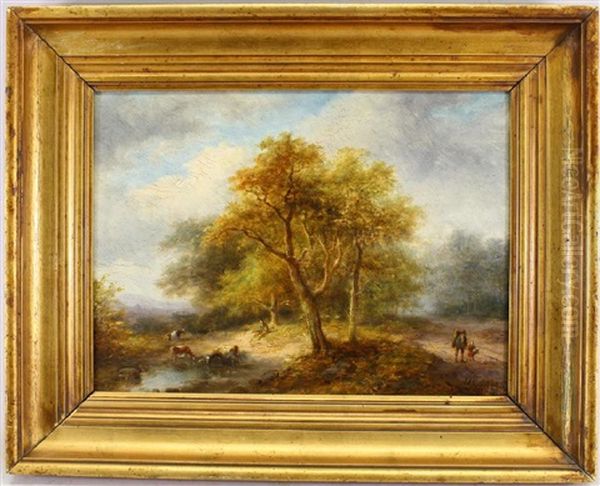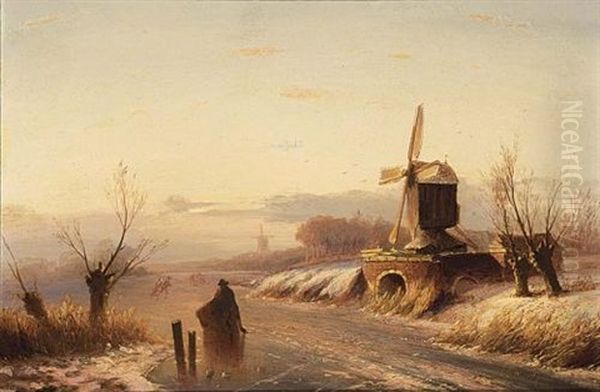Jan Evert Morel the Younger stands as a notable figure within the rich tapestry of 19th-century Dutch art. Born in Amsterdam in 1835 and passing away in Weesp in 1905, his life spanned a period of significant transition in European art. While perhaps not as globally renowned as some of his Dutch predecessors from the Golden Age or successors from the Hague School, Morel carved a distinct niche for himself as a dedicated and skilled landscape painter, capturing the sylvan beauty of the Netherlands with a blend of Romantic sensibility and meticulous technique.
His contribution lies primarily in the realm of landscape painting, a genre deeply embedded in Dutch artistic identity since the 17th century. Morel the Younger specialized in depicting lush, wooded scenes, often rendered on a modest scale, inviting intimate contemplation of nature's intricacies. His work reflects the prevailing tastes of his time while also showcasing his individual approach to composition, detail, and atmosphere.
Artistic Lineage and Early Development
Jan Evert Morel the Younger was born into an artistic environment. His father, C. J. Morel, was a recognized marine painter. It was under his father's tutelage that the young Jan Evert likely received his initial artistic training. However, while C. J. Morel dedicated himself to capturing the drama and expanse of the sea, Jan Evert turned his gaze inland, choosing the forest and the countryside as his primary subjects. This divergence in subject matter highlights a conscious artistic choice, moving away from maritime themes towards the pastoral and the sylvan.
Living and working primarily in Amsterdam for much of his life, Morel the Younger was immersed in the city's artistic milieu. He actively participated in the art scene, exhibiting his works between 1853 and 1874. This period corresponds with the flourishing of Romanticism in Dutch landscape painting, an era that looked back to the Golden Age masters while infusing scenes with a new emotional depth and often idealized beauty.
The Influence of Koekkoek and the Romantic Style

A pivotal influence on Jan Evert Morel the Younger's artistic development was Bernard Cornelis Koekkoek (1803-1862), arguably the most celebrated Dutch landscape painter of the Romantic period. Koekkoek, often hailed as the "Prince of Landscape Painting," was renowned for his meticulously detailed, often idealized forest scenes and panoramic views, sometimes imbued with an "Italianate" light and atmosphere, even when depicting Dutch or German scenery. This influence is clearly discernible in Morel's work.
Following Koekkoek's example, Morel embraced a style characterized by fine brushwork, careful attention to detail – particularly in the rendering of foliage, tree bark, and light – and a tendency towards romanticized depictions of nature. His landscapes are rarely wild or untamed; instead, they often present an orderly, harmonious vision of the natural world, bathed in gentle, often golden light. This approach combined the technical precision admired in earlier Dutch art with the subjective emotional response central to Romanticism.
Morel's paintings frequently feature towering trees that create a sense of enclosure and tranquility. The play of light filtering through leaves, illuminating patches of the forest floor or reflecting off water surfaces, is a recurring motif. His palette often relied on rich greens, warm browns, and touches of gold and silver, enhancing the idyllic and sometimes slightly nostalgic atmosphere of his scenes.
Subject Matter and Signature Style
Morel the Younger predominantly focused on woodland interiors, riverbanks, and quiet country paths. While he occasionally undertook larger canvases, the majority of his output consists of smaller panel paintings. This preference for a more intimate scale aligns with the detailed nature of his work, encouraging viewers to look closely and appreciate the fine execution. These smaller works were well-suited for the domestic interiors of the burgeoning middle-class collectors of the 19th century.
A characteristic feature of Morel's landscapes is the inclusion of small figures, known as staffage. These figures – perhaps a mother and child strolling, peasants tending livestock, or companions resting by the wayside – are rendered with the same meticulous care as the surrounding landscape. However, they are invariably dwarfed by the scale of nature, particularly the majestic trees. This compositional device serves to emphasize the grandeur and permanence of the natural world in contrast to the transient presence of humanity, a common theme in Romantic landscape painting.
His works often evoke a sense of peace and serenity. Even scenes depicting everyday rural life are imbued with a gentle, picturesque quality. The meticulous detail, while impressive, avoids becoming merely photographic; it serves instead to heighten the idealized reality he presents, inviting the viewer into a tranquil, sun-dappled world.
Representative Works: Capturing the Idyllic

While specific titles are sometimes elusive or generic, the description provided for a work titled Pair of Landscapes offers insight into his typical compositions. These paintings reportedly depict riverbank scenes populated by various figures engaged in leisurely activities: a mother with her child, a farmer and his wife, friends conversing. The detailed rendering of these figures, set against a backdrop of lush vegetation and flowing water under a luminous sky, exemplifies his approach.
The emphasis, despite the detailed figures, remains on the encompassing natural setting. The figures animate the scene and provide narrative interest, but they are ultimately subordinate elements within the larger landscape composition. This balance reflects the Romantic era's fascination with nature as both a beautiful backdrop for human life and a powerful entity in its own right. His dedication to depicting trees, often the dominant elements in his compositions, showcases his skill in capturing their varied forms and textures.
Morel in the Context of 19th-Century Dutch Painting
To fully appreciate Jan Evert Morel the Younger's place in art history, it's essential to view him within the broader context of 19th-century Dutch art. Following the economic and political upheavals of the late 18th and early 19th centuries, Dutch art experienced a period of reorientation. The towering legacy of the 17th-century Golden Age, with masters like Rembrandt van Rijn, Johannes Vermeer, Jacob van Ruisdael, and Meindert Hobbema, cast a long shadow.
In the early 19th century, landscape painting saw a resurgence, often characterized by a Romantic sensibility. Artists like Andreas Schelfhout (1787-1870), who was B.C. Koekkoek's teacher, gained fame for their winter scenes and summer landscapes, executed with considerable technical skill. B.C. Koekkoek himself then elevated this detailed Romantic landscape style to international prominence. Morel the Younger clearly belongs to this lineage, working in the meticulous, often idealized manner popularized by Koekkoek and his followers. The Koekkoek family itself was an artistic dynasty, including marine painters like Hermanus Koekkoek Sr. and other landscape artists like Marinus Adrianus Koekkoek.
Morel's career also overlapped with the emergence of the Hague School later in the century. This influential movement, including artists such as Jozef Israëls, Jacob Maris, Anton Mauve, Hendrik Willem Mesdag, and Willem Maris, marked a shift away from the detailed finish and idealized subjects of Romanticism. Hague School painters favoured a looser, more atmospheric style, often depicting everyday rural life and coastal scenes with greater realism and attention to mood and light, influenced partly by the French Barbizon School painters like Jean-Baptiste-Camille Corot.
Morel the Younger, however, remained largely faithful to the earlier Romantic tradition established by Koekkoek. His detailed execution and preference for serene, somewhat idealized woodland scenes set his work apart from the tonalism and freer brushwork of the Hague School. He represents a continuation of the Romantic landscape aesthetic that had dominated the first half of the 19th century in the Netherlands. Other contemporaries working in detailed styles, though perhaps different subjects, included artists like Wouter Verschuur, known for his depictions of horses often within landscape settings.
Exhibitions, Collections, and Recognition
Jan Evert Morel the Younger achieved a degree of recognition during his lifetime, evidenced by his regular exhibitions in Amsterdam between 1853 and 1874. His works found favour with collectors who appreciated his technical skill and the pleasing, tranquil nature of his subjects. The quality and condition of his surviving works suggest they were valued possessions.
Today, his paintings are held in significant public collections, testifying to his enduring, if modest, reputation. Notably, works by Morel the Younger can be found in the prestigious Rijksmuseum in Amsterdam, the national museum of the Netherlands, which houses an unparalleled collection of Dutch art. His paintings are also represented in the collection of the Hermitage Museum in St. Petersburg, Russia, one of the world's largest and oldest museums, known for its extensive holdings of European art. The presence of his work in such esteemed institutions confirms his status as a recognized master within the Dutch school of his period.
His paintings also appear on the art market, with auction estimates reflecting his standing as a competent and collectible artist of the Dutch Romantic school. While perhaps not reaching the prices commanded by his mentor B.C. Koekkoek or the leading figures of the Hague School, his works are sought after by those interested in 19th-century Dutch landscape painting.
Artistic Legacy and Evaluation
In assessing Jan Evert Morel the Younger's contribution to art history, he emerges as a skilled and dedicated practitioner of the Dutch Romantic landscape tradition. His strength lay in his meticulous technique, his ability to render the textures and light of woodland scenes, and his creation of harmonious, peaceful compositions. He successfully absorbed the influence of B.C. Koekkoek, adapting that master's popular style to his own sensitive depictions of nature.
His focus on detailed, often small-scale works, and his adherence to the Romantic style in an era that increasingly moved towards Realism (as exemplified by the Hague School), perhaps limited his broader impact. He is not generally considered a major innovator who significantly altered the course of Dutch art. However, within his chosen genre and style, he produced works of consistent quality and charm.
His paintings offer valuable insight into the continuation of the Romantic landscape tradition in the Netherlands well into the second half of the 19th century. They stand as fine examples of the detailed, idealized approach to nature that captivated artists and audiences before the advent of Impressionism and subsequent modern movements. He remains a respected figure among specialists and collectors of 19th-century Dutch art, a chronicler of the serene beauty of the Dutch countryside as seen through a Romantic lens. His work serves as a testament to the enduring appeal of landscape painting and the specific character of the Dutch contribution to this genre during the Romantic era.